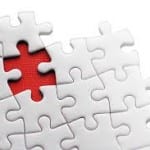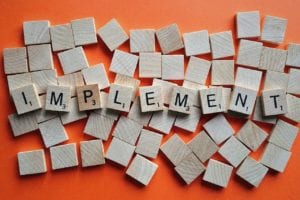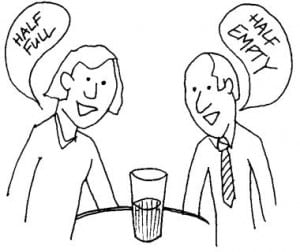The formation of situational awareness begins with perception. What you perceive becomes the foundation for understanding. What you understand then becomes the primer for prediction: Perception – Understanding – Prediction. This is how situational awareness is formed. Let’s explore one of the barriers to situational awareness that can occur if you shortcut the size-up process.
Perception
Perception is a mechanical process that involves gathering information using your senses (e.g., seeing, hearing, tasting, smelling and feeling). When I am teaching situational awareness classes, I term this information gathered by using the senses, as “clues and cues.” The clues and cues are puzzle pieces. The puzzle pieces are then formed together and you become aware of what is happening around you. While this does not complete the entire process of forming situational awareness, it does describe two-thirds of the process.
 Holes in the puzzle
Holes in the puzzle
Completing a proper size-up allows you to gather the puzzle pieces that form understanding. Your brain then fits the pieces together and you comprehend what is happening at the emergency scene. If you shortcut the process of completing a size-up there will, naturally, be holes in your puzzle because there are missing pieces.
When this happens, one of two things will happen.
“Sharon! I’m so confused.”
For reasons I cannot explain, this phrase, belted out by Ozzie Osborne during one of the episodes of his TV show, just popped into my mind. Sorry. Missing puzzle pieces can cause confusion because the incomplete puzzle can cause you to question the meaning of the pieces you did capture. In other words, there is not a coherent understanding of what is happening because the missing pieces can leave you bewildered. This is one of the better outcomes you can hope for. I’ll talk more about that in a moment.
If you don’t know… just take a guess.
 Much more dangerous than confusion is a phenomenon your brain can engage where the missing puzzle pieces are filled in with a false reality – make believe. The brain doesn’t like to be confused, so it often fills in missing information with made up information. The problem is, when it does that you don’t necessarily know your picture of understanding… is NOT reality (because it has been partially imagined).
Much more dangerous than confusion is a phenomenon your brain can engage where the missing puzzle pieces are filled in with a false reality – make believe. The brain doesn’t like to be confused, so it often fills in missing information with made up information. The problem is, when it does that you don’t necessarily know your picture of understanding… is NOT reality (because it has been partially imagined).
The more training and experience you have, the more likely your brain is to fill in the missing puzzle pieces with a close representation of reality. When there are pieces missing, your brain goes back into memory stores of past training and experience and fills in the holes with what the brain thinks SHOULD be there. The brain also takes into consideration the information that you did capture and the information that was shared with you by dispatch while you were responding (which, unto itself, can present HUGE situational awareness issues when the information being shared by dispatch is not accurate).
Confusion versus false reality
Is it better to be confused or to think you know what’s going on based on a false reality? The short answer is both can put you in an uncomfortable (and dangerous) position. However, given the two, it might arguably be better if you are confused… so long as you are aware that confusion means you are lacking understanding and you need to bring clarity to the situation by gathering and assessing more information.
Conversely, when you are operating on a false reality, chances are good you’ll have no idea you are. There will be no outward manifestation of false confidence because you don’t realize it is false… until there is a near-miss or a casualty event and then, in hindsight, you will be able to see reality did not fit your perception. By then, however, it may be too late.
Dr. Gasaway’s Advice
 The best way to avoid confusion or the formation of a false reality is to take the time to complete an accurate size-up of the situation prior to engaging in a high-risk, high consequence activity. Granted, there are instances when you will arrive at an emergency and time will be of the essence. While there may seem to be “no time to waste”, keep in mind that the size-up is not a waste of time. It is an investment in the formation of strong situational awareness which, in turn, becomes the foundation for your good decision making.
The best way to avoid confusion or the formation of a false reality is to take the time to complete an accurate size-up of the situation prior to engaging in a high-risk, high consequence activity. Granted, there are instances when you will arrive at an emergency and time will be of the essence. While there may seem to be “no time to waste”, keep in mind that the size-up is not a waste of time. It is an investment in the formation of strong situational awareness which, in turn, becomes the foundation for your good decision making.
Can you make a good decision with flawed situational awareness? Certainly you can. That’s called LUCK and you can only be so lucky for so long. It’s better to be good than lucky, especially in a vocation where so many things can go wrong so quickly. Take the time to gather the puzzle pieces during size-up. It will improve your situational awareness.
Action Items
 1.Discuss a time when being confused compelled you to investigate further to improve your understanding. Discuss how the addition of facts changed your understanding and improved your situational awareness.
1.Discuss a time when being confused compelled you to investigate further to improve your understanding. Discuss how the addition of facts changed your understanding and improved your situational awareness.
2. Discuss a time when you suffered from a false reality because your brain was making things up and you didn’t realize it. Discuss the consequences or potential consequences from your experience with a false reality.
3. Discuss how to overcome temptations to shortcut the process of completing a size-up and forming strong situational awareness.
4. Discuss the critical pieces of information you would want to gather (as facts) while completing a size-up. This will vary depending on the scenario you are discussing (e.g., residential dwelling fire, EMS call, haz-mat spill, wild land fire, high-rise fire).
_____________________________________________________

If you are interested in taking your understanding of situational awareness and high-risk decision making to a higher level, check out the Situational Awareness Matters Online Academy.
CLICK HERE for details, enrollment options and pricing.
__________________________________
Share your comments on this article in the “Leave a Reply” box below. If you want to send me incident pictures, videos or have an idea you’d like me to research and write about, contact me. I really enjoy getting feedback and supportive messages from fellow first responders. It gives me the energy to work harder for you.
Thanks,

Email: Support@RichGasaway.com
Phone: 612-548-4424
SAMatters Online Academy
Facebook Fan Page: www.facebook.com/SAMatters
Twitter: @SAMatters
LinkedIn: Rich Gasaway
YouTube: SAMattersTV
iTunes: SAMatters Radio

